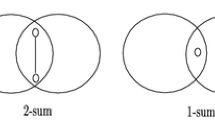Abstract
We suggest a new optical solution for solving the YES/NO version of the Exact Cover problem by using the massive parallelism of light. The idea is to build an optical device which can generate all possible solutions of the problem and then to pick the correct one. In our case the device has a graph-like representation and the light is traversing it by following the routes given by the connections between nodes. The nodes are connected by arcs in a special way which lets us to generate all possible covers (exact or not) of the given set. For selecting the correct solution we assign to each item, from the set to be covered, a special integer number. These numbers will actually represent delays induced to light when it passes through arcs. The solution is represented as a subray arriving at a certain moment in the destination node. This will tell us if an exact cover does exist or not.
Similar content being viewed by others
Explore related subjects
Discover the latest articles, news and stories from top researchers in related subjects.References
Adleman, L., “Molecular computation of solutions to combinatorial problems,” Science Vol. 266, pp. 1021–1024, 1994.
Agrawal G.P. (2002). Fiber-optic communication systems. Wiley-Interscience (3rd Edition), 2002.
Bajcsy, M., Zibrov, A.S. and Lukin, M.D., “Stationary pulses of light in an atomic medium,” Nature, Vol. 426, pp. 638–641, 2003.
Cormen, T.H., Leiserson, C.E. and Rivest, R.R., Introduction to algorithms (Second Edition), MIT Press, 2001.
Collings, N., Sumi, R., Weible, K.J., Acklin, B. and Xue, W., “The use of optical hardware to find good solutions of the travelling salesman problem (TSP),” in Proc. SPIE 1806, pp. 637–641, 1993.
Desurvire, E., Simpson. J. and Becker, P.C., “High-gain erbium-doped travelingwave fiber amplifier” Optics Letters, Vol. 12, No. 11, pp. 888–890, 1987.
Faist, J., “Optoelectronics: silicon shines on,” Nature, Vol. 433, pp. 691–692, 2005.
Flyckt, S.O. and Marmonier, C., Photomultiplier tubes: Principles and applications. Photonis, Brive, France, 2002.
Garey, M.R. and Johnson, D.S., Computers and intractability: A guide to NPCompleteness, Freeman & Co, San Francisco, CA, 1979.
Goodman, J.W., “Architectural development of optical data processing systems,” Aust. J. Electr. Electron. Eng, Vol. 2, pp. 139–149, 1982.
Haist, T. and Osten, W., “An Optical Solution For The Traveling Salesman Problem,” Opt. Express, Vol. 15, pp. 10473–10482, 2007.
Hardy, J. and Shamir, J., “Optics inspired logic architecture,” Opt. Express, Vol. 15, pp. 150–165, 2007.
Hartmanis, J., “On the weight of computations,” Bulletin of the EATCS, Vol. 55, pp. 136–138, 1995.
Hau, L.V., Harris, S.E., Dutton, Z. and Behroozi, C.H., “Light speed reduction to 17 meters per second in an ultracold atomic gas,” Nature, Vol. 397, pp. 594–598, 1999.
Henkel, C., Frisco, P. and Tengely, S.Z., “An algorithm for SAT without an extraction phase,” in DNA Computing, Eleventh International Meeting on DNA Based Computers, LNCS 3892, pp. 67–80, 2005.
Lenslet website, www.lenslet.com, 2005.
Liu. C., Dutton, Z., Behroozi, C.H. and Hau, L.V., “Observation of coherent optical information storage in an atomic medium using halted light pulses,” Nature, Vol. 409, pp. 490–493, 2001.
Mears. R.J,, Reekie. L., Jauncey, I.M., and Payne, D.N., “Low-noise Erbiumdoped fibre amplifier at 1.54pm,” Electron. Lett., Vol. 23, pp. 1026–1028, 1987.
Murphy, N., Naughton, T.J., Woods, D., Henley, B., McDermott, K., Duffy, E., van der Burgt, P.J.M. and Woods, N., “Implementations of a model of physical sorting,” in From Utopian to Genuine Unconventional Computers workshop(Adamatzky A, Teuscher C, eds.), Luniver Press pp. 79–100, 2006.
Naughton, T.J., “A model of computation for Fourier optical processors,” in Optics in Computing (Lessard R.A, Galstian T eds.), Proc. SPIE 4089, pp. 24–34, 2000.
Oltean, M., “A light-based device for solving the Hamiltonian path problem,” Unconventional Computing (Calude C. et al. eds.), LNCS 4135, Springer-Verlag, pp. 217–227, 2006.
Oltean, M., “Solving the Hamiltonian path problem with a light-based computer,” Natural Computing, Vol.7-1, pp.57–70, Springer-Verlag, 2008.
Paniccia, M. and Koehl, S., “The silicon solution,” IEEE Spectrum, IEEE Press, October, 2005.
Pisinger, D., “Dynamic Programming on the word RAM,”Algorithmica, Vol. 35, pp. 128–145, 2003.
Rader, A. and Anderson, B.L., “Demonstration of a Linear Optical True-Time Delay Device by Use of a Microelectromechanical Mirror Array,” Applied Optics, Vol. 42, pp. 1409–1416, 2003.
Reif, J.H. and Tyagi, A., “Efficient parallel algorithms for optical computing with the discrete Fourier transform primitive,” Applied optics, Vol. 36(29), pp. 7327–7340, 1987.
Rong, H., Jones, R., Liu, A., Cohen, O., Hak, D., Fang, A. and Paniccia, M., “A continuous-wave Raman silicon laser,” Nature, Vol. 433, pp. 725–728, 2005.
Rong, H., Liu, A., Jones, R., Cohen, O., Hak, D., Nicolaescu, R., Fang, A. and Paniccia, M., “An all-silicon Raman laser,” Nature, Vol. 433, pp. 292–294, 2005.
Schultes, D., “Rainbow Sort: Sorting at the speed of light,” Natural Computing, Vol. 5(1), Springer-Verlag, pp. 67–82, 2005.
Shaked, N.T., Messika, S., Dolev, S. and Rosen, J., “Optical solution for bounded NP-complete problems,” Applied Optics, Vol. 46, pp. 711–724, 2007.
Sloane, N., “The on-line encyclopedia of integer sequences” http://www:research.att.com/~njas/sequences/A023758, 2006.
Vergis, A., Steiglitz, K. and Dickinson, B., “The complexity of analog computation,” Mathematics and Computers in Simulation, Vol. 28(2), pp. 91–113, 1986.
Woods, D., Naughton, T.J., “An optical model of computation,” Theoretical Computer Science, Vol. 334 (1-3), pp. 227–258, 2005.
Optical Character Recognition @ Wikipedia, http://en.wikipedia.org/wiki/Optical_character_recognition, 2006.
List of refractive indices @ Wikipedia, http://en.wikipedia.org/wiki/List_of_refractive_indices, 2007.
Author information
Authors and Affiliations
Corresponding author
About this article
Cite this article
Oltean, M., Muntean, O. Exact Cover with Light. New Gener. Comput. 26, 329–346 (2008). https://doi.org/10.1007/s00354-008-0049-5
Received:
Revised:
Published:
Issue Date:
DOI: https://doi.org/10.1007/s00354-008-0049-5




